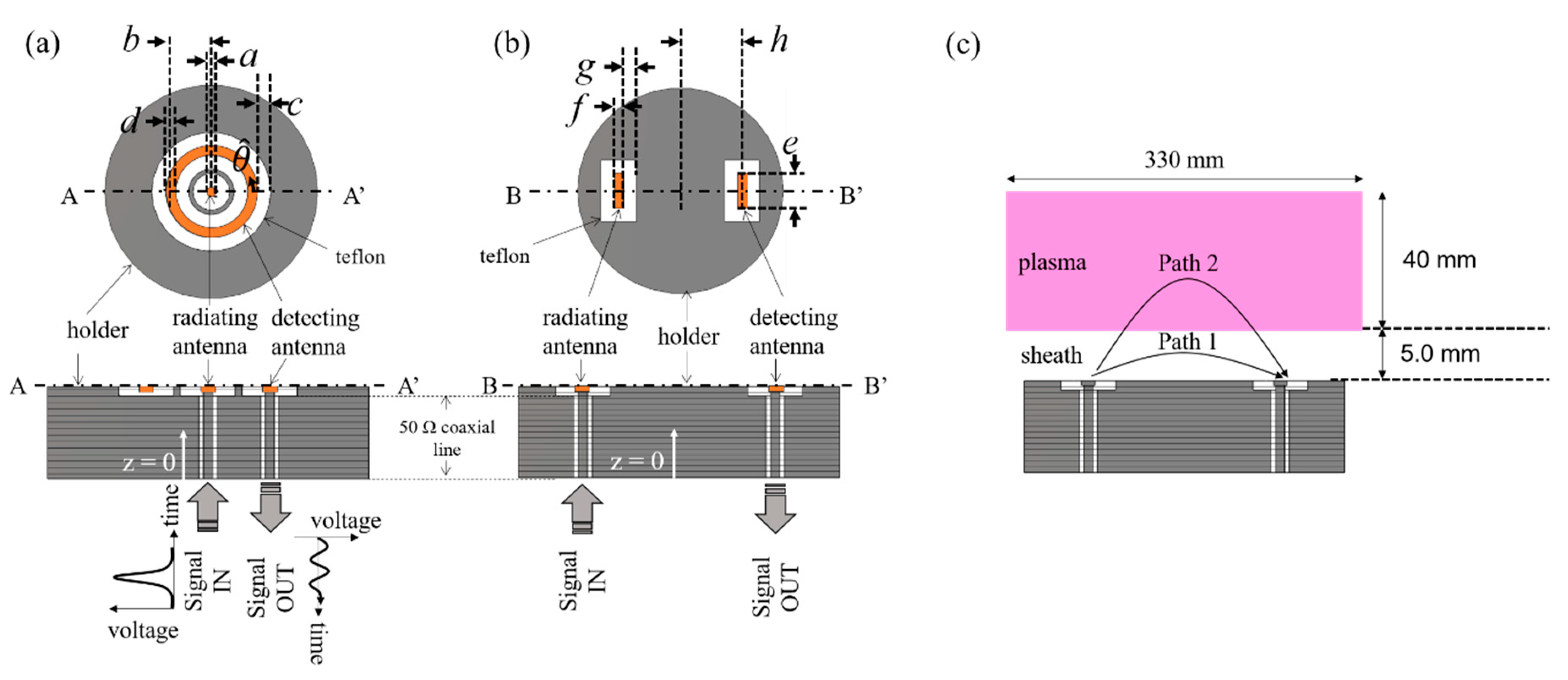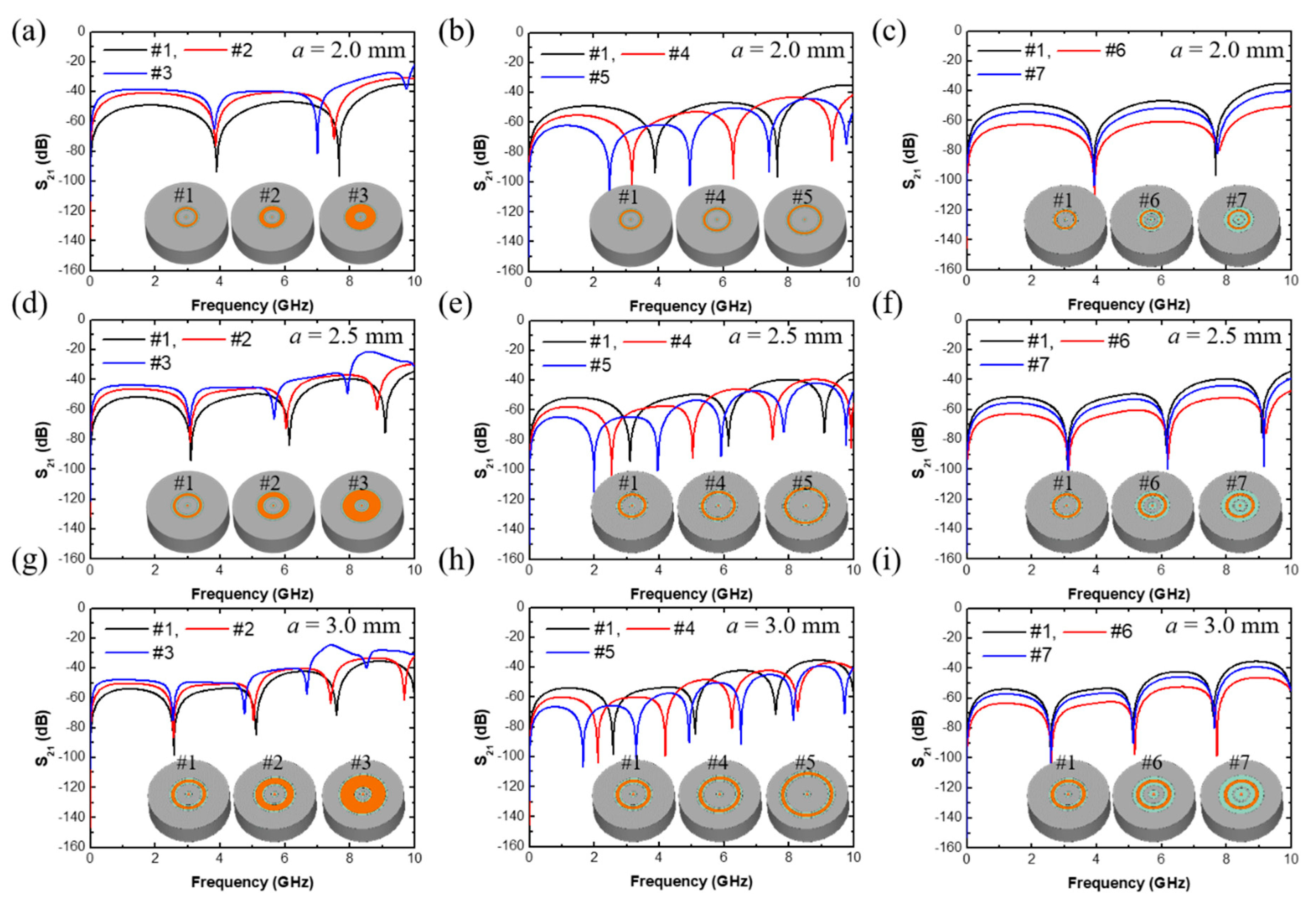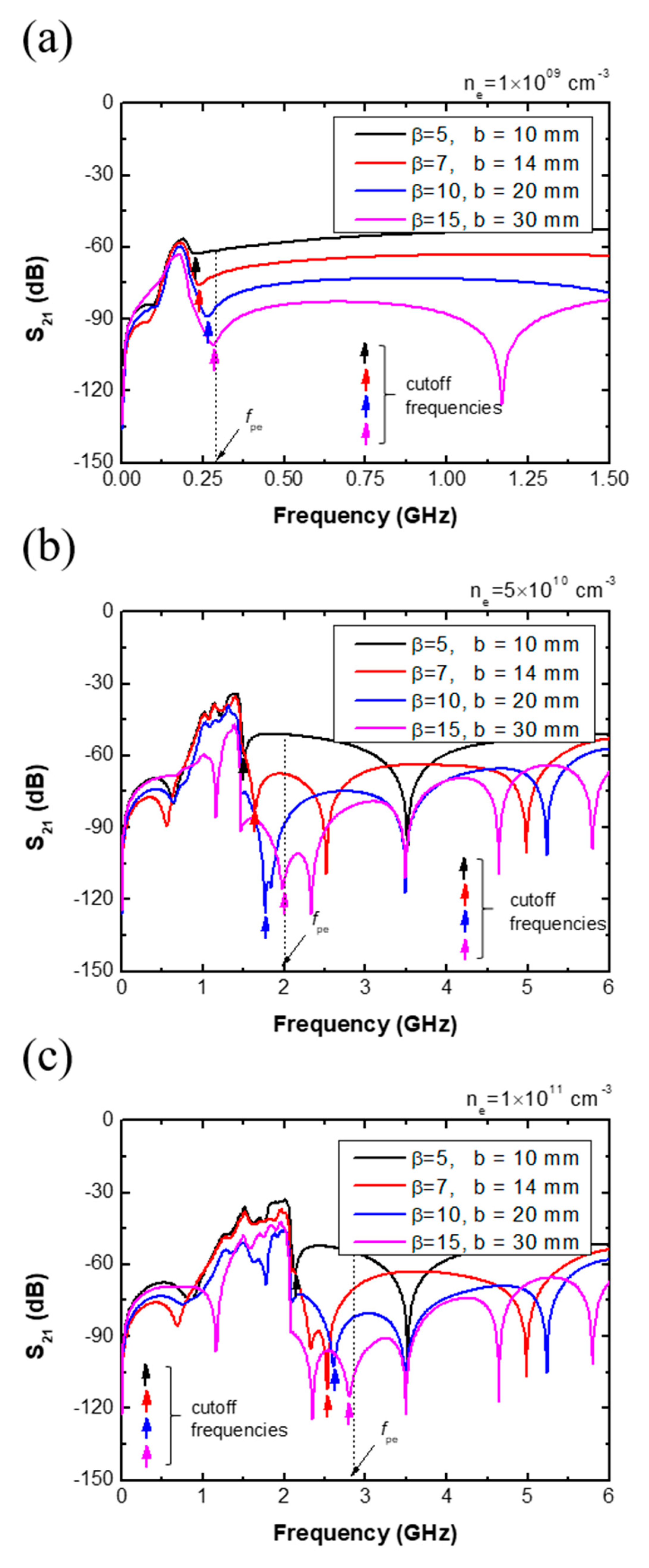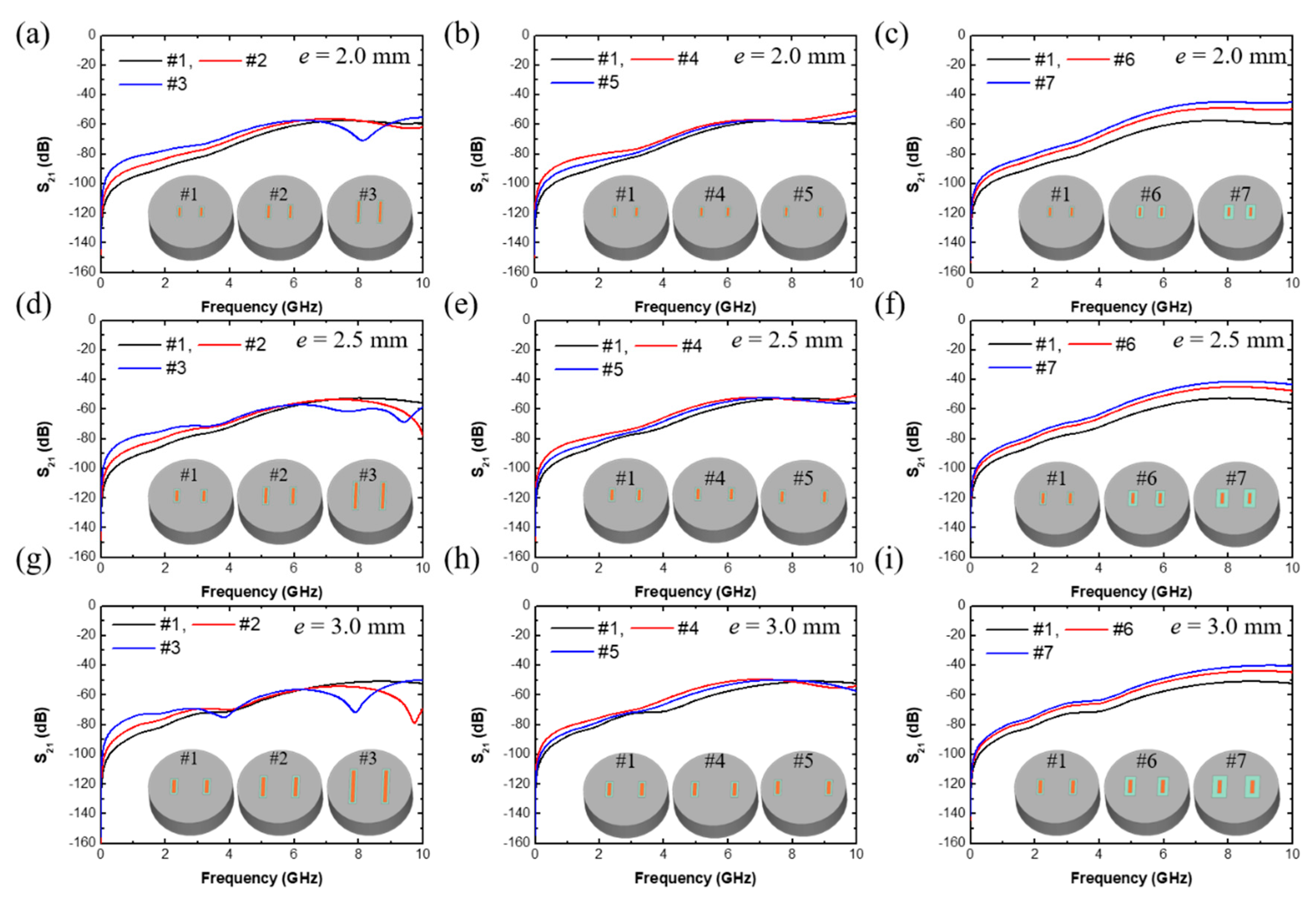Computational Characterization of Microwave Planar Cutoff Probes for Non-Invasive Electron Density Measurement in Low-Temperature Plasma: Ring- and Bar-Type Cutoff Probes
Abstract
:1. Introduction
2. Simulation Details
3. Simulation Results and Discussion
3.1. Ring-Type Cutoff Probe (RCP)
3.2. Bar-Type Cutoff Probe (BCP)
4. Conclusions
Author Contributions
Funding
Conflicts of Interest
References
- Lieberman, M.A.; Lichtenberg, A.J. Principles of Plasma Discahrges and Materials Processing, 2nd ed.; Wiley & Sons. Inc.: Hobken, NJ, USA, 2005; pp. 1–22. [Google Scholar]
- Adamovich, I.V.; Baalrud, S.D.; Bogaerts, A.; Bruggeman, P.J.; Cappelli, M.; Colombo, V.; Czarnetzki, U.; Ebert, U.; Eden, J.G.; Favia, P.; et al. The 2017 Plasma Roadmap: Low temperature plasma science and technology. J. Phys. D Appl. Phys. 2017, 50, 323001. [Google Scholar] [CrossRef]
- Umeda, S.; Nogi, K.; Shiraishi, D.; Kagoshima, A. Advanced Process Control Using Virtual Metrology to Cope With Etcher Condition Change. IEEE Trans. Semicond. Manuf. 2019, 32, 423–427. [Google Scholar] [CrossRef]
- Roh, H.-J.; Ryu, S.; Jang, Y.; Kim, N.-K.; Jin, Y.; Park, S.; Kim, G.-H. Development of the Virtual Metrology for the Nitride Thickness in Multi-Layer Plasma-Enhanced Chemical Vapor Deposition Using Plasma-Information Variables. IEEE Trans. Semicond. Manuf. 2018, 31, 232–241. [Google Scholar] [CrossRef]
- Ahn, J.-H.; Gu, J.-M.; Han, S.-S.; Hong, S.-J. Real-time In-situ Plasma Etch Process Monitoring for Sensor Based-Advanced Process Control. J. Semicond. Technol. Sci. 2011, 11, 1–5. [Google Scholar] [CrossRef]
- Kim, S.J.; Lee, J.J.; Kim, D.W.; Kim, J.-H.; You, S.J. A transmission line model of the cutoff probe. Plasma Sources Sci. Technol. 2019, 28, 055014. [Google Scholar] [CrossRef]
- Engeln, R.; Klarenaar, B.L.M.; Guaitella, O. Foundations of optical diagnostics in low-temperature plasmas. Plasma Sources Sci. Technol. 2020, 29, 063001. [Google Scholar] [CrossRef]
- You, K.H.; You, S.J.; Kim, D.W.; Na, B.K.; Seo, B.H.; Kim, J.H.; Seong, D.; Chang, H.-Y. Measurement of electron density using reactance cutoff probe. Phys. Plasmas 2016, 23, 053515. [Google Scholar] [CrossRef]
- Kim, J.-H.; Choi, S.-C.; Shin, Y.-H.; Chung, K.-H. Wave cutoff method to measure absolute electron density in cold plasma. Rev. Sci. Instruments 2004, 75, 2706–2710. [Google Scholar] [CrossRef]
- 3ds SIMULIA CST STUDIO SUITE. Available online: www.cst.com (accessed on 6 October 2020).
- Liang, I.; Nakamura, J.; Sugai, H. Modeling Microwave Resonance of Curling Probe for Density Measurements in Reactive Plasmas. Appl. Phys. Express 2011, 4, 066101. [Google Scholar] [CrossRef]
- Arshadi, A.; Brinkmann, R.P.; Hotta, M.; Nakamura, K. A simple and straightforward expression for curling probe electron density diagnosis in reactive plasmas. Plasma Sources Sci. Technol. 2017, 26, 045013. [Google Scholar] [CrossRef]
- Arshadi, A.; Brinkmann, R.P. Analytical investigation of microwave resonances of a curling probe for low and high-pressure plasma diagnostics. Plasma Sources Sci. Technol. 2016, 26, 15011. [Google Scholar] [CrossRef]
- Hotta, M.; Ogawa, D.; Nakamura, K.; Sugai, H. Real-time curling probe monitoring of dielectric layer deposited on plasma chamber wall. Jpn. J. Appl. Phys. 2018, 57, 046201. [Google Scholar] [CrossRef]
- Ogawa, D.; Nakamura, K.; Sugai, H. A novel technique for in-situ simultaneous measurement of thickness of deposited film and electron density with two curling probes. Plasma Sources Sci. Technol. 2020. [Google Scholar] [CrossRef]
- Schulz, C.; Styrnoll, T.; Awakowicz, P.; Rolfes, I. The Planar Multipole Resonance Probe: Challenges and Prospects of a Planar Plasma Sensor. IEEE Trans. Instrum. Meas. 2014, 64, 857–864. [Google Scholar] [CrossRef]
- Friedrichs, M.; Oberrath, J. The planar Multipole Resonance Probe: a functional analytic approach. EPJ Tech. Instrum. 2018, 5, 7. [Google Scholar] [CrossRef]
- Kim, D.W.; You, S.J.; Kim, S.J.; Kim, J.-H.; Lee, J.Y.; Kang, W.S.; Hur, M.S. Planar cutoff probe for measuring the electron density of low-pressure plasmas. Plasma Sources Sci. Technol. 2019, 28, 015004. [Google Scholar] [CrossRef]
- Yeom, H.J.; Kim, J.-H.; Choi, D.; Choi, E.S.; Yoon, M.Y.; Seong, D.-J.; You, S.J.; Lee, H.-C.; Hyo-Chang, L. Flat cutoff probe for real-time electron density measurement in industrial plasma processing. Plasma Sources Sci. Technol. 2020, 29, 035016. [Google Scholar] [CrossRef]
- Kim, D.W.; You, S.J.; Kim, J.H.; Chang, H.Y.; Oh, W.Y. Computational comparative study of microwave probes for plasma density measurement. Plasma Sources Sci. Technol. 2016, 25, 35026. [Google Scholar] [CrossRef]
- Kim, H.C.; Iza, F.; Yang, S.S.; Radmilović-Radjenović, M.; Lee, J.K. Particle and fluid simulations of low-temperature plasma discharges: benchmarks and kinetic effects. J. Phys. D Appl. Phys. 2005, 38, R283–R301. [Google Scholar] [CrossRef]
- Verboncoeur, J.P. Particle simulation of plasmas: review and advances. Plasma Phys. Control. Fusion 2005, 47, A231–A260. [Google Scholar] [CrossRef]
- Jackson, J.D. Classical Electrodynamics, 3rd ed.; Wiley & Sons. Inc.: Hobken, NJ, USA, 1999; p. 310. [Google Scholar]
- Na, B.-K.; Kim, D.-W.; Kwon, J.-H.; Chang, H.-Y.; Kim, J.-H.; You, S.J. Computational characterization of cutoff probe system for the measurement of electron density. Phys. Plasmas 2012, 19, 53504. [Google Scholar] [CrossRef]
- Walker, J.; Halliday, D.; Resnick, R. Principles of Physics, 10th ed.; John Wiley & Sons: Singapore, 2014; pp. 413–416. [Google Scholar]
- Mehdizadeh, M. Microwave/RF Applicators and Probes: for Material Heating, Sensing, and Plasma Generation, 2nd ed.; Elsevier Inc.: Cambridge, MA, USA, 2015; p. 99. [Google Scholar]







| Type | Ring-Type Probe | Type | Bar-Type Probe | ||||
|---|---|---|---|---|---|---|---|
| Number | α (≡ d/a) | β (≡ b/a) | γ (≡ c/a) | Number | α (≡ f/e) | β (≡ h/e) | γ (≡ g/e) |
| #1 | 1 | 4.5 | 0.5 | #8 | 4 | 4.5 | 0.5 |
| #2 | 2 | 4.5 | 0.5 | #9 | 6 | 4.5 | 0.5 |
| #3 | 4 | 4.5 | 0.5 | #10 | 10 | 4.5 | 0.5 |
| #4 | 1 | 5.5 | 0.5 | #11 | 4 | 5.5 | 0.5 |
| #5 | 1 | 7.0 | 0.5 | #12 | 4 | 7.0 | 0.5 |
| #6 | 1 | 4.5 | 1.0 | #13 | 4 | 4.5 | 1.0 |
| #7 | 1 | 4.5 | 1.5 | #14 | 4 | 4.5 | 1.5 |
© 2020 by the authors. Licensee MDPI, Basel, Switzerland. This article is an open access article distributed under the terms and conditions of the Creative Commons Attribution (CC BY) license (http://creativecommons.org/licenses/by/4.0/).
Share and Cite
Kim, S.J.; Lee, J.J.; Lee, Y.S.; Yeom, H.J.; Lee, H.C.; Kim, J.-H.; You, S.J. Computational Characterization of Microwave Planar Cutoff Probes for Non-Invasive Electron Density Measurement in Low-Temperature Plasma: Ring- and Bar-Type Cutoff Probes. Appl. Sci. 2020, 10, 7066. https://doi.org/10.3390/app10207066
Kim SJ, Lee JJ, Lee YS, Yeom HJ, Lee HC, Kim J-H, You SJ. Computational Characterization of Microwave Planar Cutoff Probes for Non-Invasive Electron Density Measurement in Low-Temperature Plasma: Ring- and Bar-Type Cutoff Probes. Applied Sciences. 2020; 10(20):7066. https://doi.org/10.3390/app10207066
Chicago/Turabian StyleKim, Si Jun, Jang Jae Lee, Young Seok Lee, Hee Jung Yeom, Hyo Chang Lee, Jung-Hyung Kim, and Shin Jae You. 2020. "Computational Characterization of Microwave Planar Cutoff Probes for Non-Invasive Electron Density Measurement in Low-Temperature Plasma: Ring- and Bar-Type Cutoff Probes" Applied Sciences 10, no. 20: 7066. https://doi.org/10.3390/app10207066
APA StyleKim, S. J., Lee, J. J., Lee, Y. S., Yeom, H. J., Lee, H. C., Kim, J.-H., & You, S. J. (2020). Computational Characterization of Microwave Planar Cutoff Probes for Non-Invasive Electron Density Measurement in Low-Temperature Plasma: Ring- and Bar-Type Cutoff Probes. Applied Sciences, 10(20), 7066. https://doi.org/10.3390/app10207066







